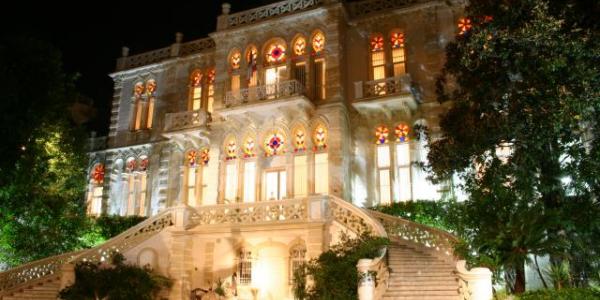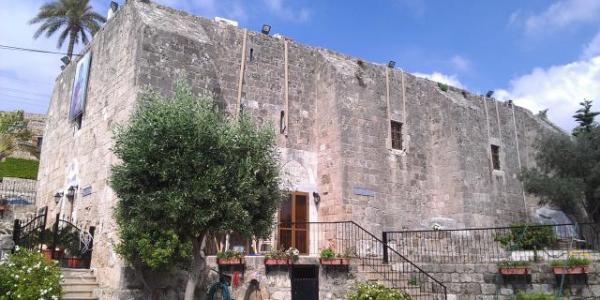St. John the Baptist Church
Commissioned by the Genovese Crusaders and built in 1115 over the remains of a Byzantine church, it was considered a cathedral and was partially destroyed during an earthquake in 1176 AD. Under the Ottoman authorities it became a Maronite church and was given to the Maronites as a gift by Prince Youssef Chehab of Lebanon in the mid-1700s, after they helped him seize the city.
This church has a hybrid style of Byzantine, Crusader and Islamic styles. It has a basilica plan with vaulted ceiling. It is a reduced church with an impressive entrance and a small porch with distinct chevron pattern on its arches, similar to patterns on several buildings in Jerusalem from the same period. This pattern influenced later decoration of Ayyubid and Mamluk architecture in the region.
Neolithic and Chalcolithic Settlements
Many remains of foundations and one-room houses date back to the Chalcolithic and Neolithic periods.
Temple of Baalat Gebal
Built towards 2700 BC by Phoenicians, this temple was dedicated to the patron goddess of the city, Astarte. The foundations are all that remain today of this temple.
The Great Temple
This L-shaped temple, dating back to around 2600 BC, is believed to have been dedicated to Reshef, the Phoenician god of war. It was destroyed by the Amorites around 2100 BC.
Amorite Quarry
Behind the remains of the Baalat Gebal temple is a 2,300 years old quarry.
Roman Theatre
The 3rd-century Roman theater, originally located between the city gate and the Great “L” temple, was moved and reconstructed near the seaside.
Necropolis
The necropolis contains nine underground tombs of Byblos Kings who lived in the second millennium B.C.
Roman Colonnade
The 4th-century Roman road once led to the Temple of Baalat Gebal and was lined with colonnades, of which only six remain.
Bronze Age City Fortifications
The Bronze Age fortification walls show successive stages of construction and restoration that took place between 2000 BC and 1580 BC.
The Crusaders Castle
It was built on a Fatimid fortified structure, in the 12th century. It reused Roman elements found onsite.
Medieval City Wall
Built by the Crusaders in the beginning of the 12th century, it was restored later on by Mamluks and Ottomans.
The Persian Castle
Built during the Persian period, only the castle walls foundations and the square-shaped towers made it till today and are located outside the Early Bronze Age walls.
The temple of the Obelisks
Built between 2150 and 1600 BC, it is composed of 26 sandstone and limestone monoliths standing on square stone bases used as religious offerings, probably to Reshef, the Phoenician god of war. The numerous small obelisks and bronze figurines displayed in the National Museum come from this temple.
The Harbour & Harbour Towers

The Crusaders built defensive towers on either sides of the entrance of Byblos’s small harbour. The Northern tower was restored by both Mamluks and Ottomans.
Al Sultan Ibrahim Adham Mosque
This is a small Mamluk Mosque located just 50 meters uphill, behind Byblos fishing club.
Roman Road
The Roman Cardo Maximus was once the entrance of Byblos. Traces of the original paving still remain and parts of the colonnades have been reconstructed.
Roman Nymphaeum
At the end of the Roman Colonnade, towards the old souk, we can see the foundations of a nymphaeum.
Saydet al Bouebeh Church
This small 18th-century oratory was built next to the northern gate of the city wall.
Sultan Abd al Majid Mosque
Built in 1648 on the ruins of the Fatimid Mosque, it was renovated by the Emir Youssef Chehab in 1783.
Byblos Site Museum
Objects and information about the Bronze Age, and the Hellenistic and Roman eras found in the archeological excavation of Byblos are displayed there.
Umayyad Museum
This room contains treasures from the private Louis Cardahi collection, including:
- Phoenician artifacts, such as a statuette of Ishtar-Aphrodite taking her ablution;
- Oil lamps and small glass vases;
- Lithographs by the famous archeologist Ernest Renan;
- Reproduction from the Louvre Museum: bust of Osorkon, stone of Yehawmilk, basalt lion of the Persian fortress.
Access to the museum is free of charge. Its hours of operation are Tuesday to Friday from 08:00 AM to 04:00 PM and Saturday to Sunday from 10:00 AM to 08:00 PM. The museum closes on Mondays and official holidays. Please refer to the following link: Umayyad Museum




